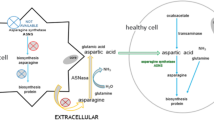Abstract
A new derivative ofL-asparaginase, palmitoyl-L-asparaginase (palmitoyl-L-ASNase), has been incorporated in liposomes. For this purpose we modified the dehydration-rehydration method and optimized the liposomal composition. The pharmacokinetics, toxicity, and in vivo antitumor activity against P1534 lymphoma of different liposomal palmitoyl-L-ASNase formulations were studied. Liposomal encapsulation of palmitoyl-L-ASNase as compared with free palmitoyl-L-ASNase resulted in a prolongation of the blood half-life (from 2.88 h to longer than 23.7 h), abrogation of acute toxicity, and preservation of in vivo antitumor activity.
Similar content being viewed by others
References
Allen TM, Chonn A (1987) Large unilamellar liposomes with low uptake into the reticuloendothelial system. FEBS Lett 223:42–46
Asselin BL, Ryan D, Frantz N, Bernal SD, Leavitt P, Sallan SE, Cohen HJ (1989) In vitro and in vivo killing of acute lymphoblastic leukemia cells byL-asparaginase. Cancer Res 49: 4363–4368
Broome JD (1981)L-Asparaginase: discovery and development as a tumor-inhibitory agent. Cancer Treat Rep 65 [Suppl 4]:111–114
Capizzi RL, Cheng Y-C (1981) Treatment of neoplasia with asparaginase. In: Holcenberg JC (ed) Enzymes as drugs. J. Wiley and Sons, New York Chicester Brisbane Toronto Singapore, pp 2–24
Capizzi RL, Handschumacher RE (1982) Asparaginase. In: Holland JF, Frei E III (eds) Cancer medicine. Lea and Febiger, Philadelphia, pp 920–933
Chang TMS (1971) The in vivo effect of semipermeable microcapsules containing L-Asparaginase on 6C3HED lymphosarcoma. Nature 229:117–118
Charles LM Jr, Bono VH Jr (1981) A review of the preclinical antitumor activity and toxicology ofL-asparaginase derived fromE. coli. Cancer Treat Rep 65 [Suppl 4]:39–46
Clarkson B, Krakoff I, Burchenal J, Karnofsky D, Golbey R, Dowling M, Oettgen H, Lipton A (1970) Clinical results of treatment withE. coli L-asparaginase in adults with leukemia, lymphoma and solid tumors. Cancer 25:279–305
Cruz ME, Corvo ML, Jorge JS, Lopes F (1989) Liposomes as carriers of proteins: factors affecting protein encapsulation. In: Lopez-Berenstein G, Fidler IJ (eds) Liposomes in the therapy of infectious diseases and cancer. Alan R. Liss, New York, pp 417–426
Cruz MEM, Gaspar MM, Lopes F, Jorge JS, Perez-Soler R (1993) LiposomalL-asparaginase: in vitro evaluation. Int J Pharm 96: 67–77
Dousset N, Douste-Balazy L (1985) Méthodes de préparation des liposomes. In: Puisieux F, Delattre J (eds) Les liposomes: applications thérapeutiques. Technique et Documentation-Lavoisier, Paris, pp 41–72
Fishman Y, Citri N (1975)L-Asparaginase entrapped in liposomes: preparation and properties. FEBS Lett 60:17–20
Fiske CH, Subbarow J (1925) The colorimetric determination of phosphorus. J Biol Chem 66:375–400
Gabizon A, Papahadjopoulos D (1988) Liposome formulations with prolonged circulation time in blood and enhanced uptake by tumors. Proc Natl Acad Sci USA 85:6949–6953
Gregoriadis G, Leathwood PD, Ryman BE (1971) Enzyme entrapment in liposomes. FEBS Lett 14:95–99
Haskell CM (1981)L-Asparaginase: human toxicology and single agent activity in nonleukemic neoplasms. Cancer Treat Rep 65 [Suppl 4]:57–59
Ho DH, Brown NS, Yen A, Holmes R, Keating M, Abuchowski A, Newman RA, Krakoff IH (1986) Clinical pharmacology of polyethylene glycol-L-asparaginase. Drug Metab Dispos 14:349–352
Jayaram HN, Cooney DA, Jayaram S, Rosenblum L (1974) A simple and rapid method for the estimation ofL-asparaginase in chromatographic and electrophoretic effluents: comparison with other methods. Anal Biochem 59:327–346
Juliano RL (1988) Factors affecting the clearance kinetics and tissue distribution of liposome, microspheres and emulsions. Adv Drug Deliv Rev 2:37–54
King EJ (1932) The colorimetric determination of phosphorus. Biochem J 26:292–297
Kirby C, Gregoriadis G (1984) Dehydration-rehydration vesicles: a simple method for high yield drug entrapment in liposomes. Biotechnology November: 979–984
Land VJ, Sutow WW, Fernbach DJ, Lane DM, Williams TE (1972) Toxicity ofL-asparaginase in children with advanced leukemia. Cancer 30:339–347
Lowry OH, Rosebrough NJ, Farr AL, Randall RT (1951) Protein measurement with the Folin phenol reagent. J Biol Chem 193: 265–275
Martins MBF, Jorge JCS, Cruz MEM (1990) Acylation ofL-asparaginase with total retention of enzymatic activity Biochimie 72: 671–675
Mashburn LT, Wriston JC Jr (1964) Tumor inhibitory effect ofL-asparaginase fromEscherichia coli. Arch Biochem Biophys 105: 450–452
Mori T, Tosa T, Chibata I (1973) Enzymatic properties of microcapsules containing Asparaginase like also to include the last page number of this. Biochim Biophys Acta 321:653–661
Neerunjun ED, Gregoriadis G (1976) Tumour regression with liposome-entrapped asparaginase: some immunological advantages. Biochem Soc Trans 4:133–134
Oettgen HF, Stephenson PA, Schawartz MK, Leeper RD, Tallal L, Tan CC, Clarkson BD, Golbey RB, Krakoff IH, Karnofsky DA, Murphy ML, Burchenal JH (1970) Toxicity ofE. coli L-asparaginase in man. Cancer 25:253–278
Oshawa T, Miura H, Harada K (1985) Evaluation of a new lipsome technique, the freeze-thawing method, usingL-asparaginase as a model drug. Chem Pharm Bull (Tokyo) 33:2916–2923
Roberts J, Prager MD, Bachynsky N (1966) The antitumor activity ofEscherichia coli L-asparaginase. Cancer Res 26:2213–2217
Saito M, Asakura H, Jokaji H, Uotani C, Kumabashiri I, Ito K, Matsuda T (1989) Changes in hemostatic and fibrinolytic proteins in patients receivingL-asparaginase therapy. Am J Hematol 32: 20–23
Wang C-H, Smith RL (1975) Lowry determination of the protein in the presence of Triton X-100. Anal Biochem 63:414–417
Author information
Authors and Affiliations
Rights and permissions
About this article
Cite this article
Jorge, J.C.S., Perez-Soler, R., Morais, J.G. et al. Liposomal palmitoyl-L-asparaginase: characterization and biological activity. Cancer Chemother. Pharmacol. 34, 230–234 (1994). https://doi.org/10.1007/BF00685082
Received:
Accepted:
Issue Date:
DOI: https://doi.org/10.1007/BF00685082




